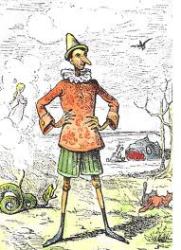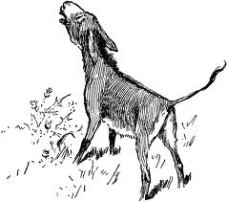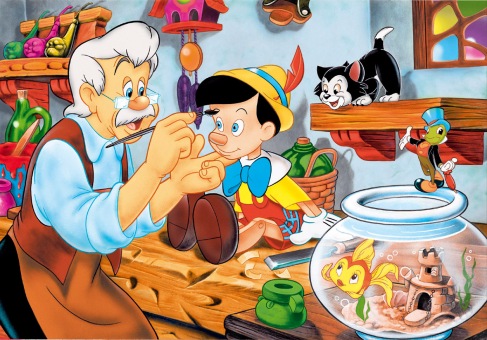In Walt Disney’s animated film Pinocchio, supposedly every time Pinocchio lies, his nose becomes longer per lie, which puts forward a moral for this film’s intended child audience. Pinocchio is depicted as naïve and a bit naughty, but he learns that lying is wrong due to the lie-detecting and –revealing functions of his nose. However, in the original written work, Pinocchio is definitely a naughty and rambunctious “child” puppet, and in Carlo Collodi’s Pinocchio, there is a lot of wooden nose growing and lying on the part of this puppet protagonist, but it is not all as consistent as in the Disney version.
 In Chapter 3 of Collodi’s published novel, Pinocchio is carved out of wood, and as soon as Old Joe got to work on the nose, it started to grow longer and longer. At this point he had not carved out Pinocchio’s mouth yet, and so the reason for the growth in this first appearance is not lying. However, when Pinocchio has recovered at the Fairy’s house in Chapter 17, he lies to the Fairy about the location of his gold coins, and with each lie, his nose grows to an obscene length. He cannot even turn in the room without harm. The title of this chapter even bluntly describes his nose lengthening as the resulting negative consequence for lying: “How Pinocchio … tells a lie and as a punishment his nose grows long.” Here are two cases of nose growth in the book, which do not consistently link lying and nose growth.
In Chapter 3 of Collodi’s published novel, Pinocchio is carved out of wood, and as soon as Old Joe got to work on the nose, it started to grow longer and longer. At this point he had not carved out Pinocchio’s mouth yet, and so the reason for the growth in this first appearance is not lying. However, when Pinocchio has recovered at the Fairy’s house in Chapter 17, he lies to the Fairy about the location of his gold coins, and with each lie, his nose grows to an obscene length. He cannot even turn in the room without harm. The title of this chapter even bluntly describes his nose lengthening as the resulting negative consequence for lying: “How Pinocchio … tells a lie and as a punishment his nose grows long.” Here are two cases of nose growth in the book, which do not consistently link lying and nose growth.
Pinocchio also lies many times throughout the novel, and not on all occasions does his nose react the way it does in the Disney film version of the story. In Chapter 32, Pinocchio has started to transform into a Donkey in The Land of Toys and has acquired ears. He then visits Candle-Wick, and the two boys share lies about why they are wearing night caps:
“‘… my dear Pinocchio, why are you wearing this cotton nightcap pulled down to your nose?’
‘The doctor prescribed it because I’ve got a sore foot.’ (Collodi 133)
Although the reader knows that Pinocchio is plainly lying, there is not the expected consequence. Then again in Chapter 36 Pinocchio lies to his father about going into town to buy himself nice clothes. He did not buy clothes because he gave his earnings to the Fairy’s snail in order to help financially support his Fairy mother/sister who is then poor and sick in the hospital unable to feed herself. After this encounter between the wooden puppet and the Snail, Pinocchio returns home and tells his inquiring father that he could not find clothes that “suited” him (Collodi 167). Once again, Pinocchio is not punished for lying. In fact, we could even classify this lie he told Old Joe as a white lie since Pinocchio’s lie does not hurt anyone but only hides his kind act, but it is still a lie left without the expected consequence if one is thinking about the widely popular Disney movie version.
In Collodi’s Pinocchio there is an instance of nose growth that isn’t preceded by a lie, and there is an instance where Pinocchio tells lies and then his wooden nose’s length increases. Then to contrast this latter scene of lying, there are at least two notable scenes where Pinocchio lies but with no elongation of his nose. Is there anything to this? It is understandable why Walt Disney’s version of the story consistently and reliably links lying and nose growth to teach the audience not to lie. The moral it imparts is that lying is bad and will be punished. However, due to the inconsistencies in the original, was it Collodi’s intention to impart the same lesson?

I do believe that Collodi did intend to teach children not to lie if one were to look at Chapter 17 by itself. Pinocchio was initially serialized, meaning that the readers got to read each chapter singly as each chapter was published in a weekly reader. Thus, the inconsistencies regarding lying and nose growth are most likely not planned and a result of a serialized and episodic format. Despite that, I feel that this may more accurately represent reality. In reality, sometime we feel negative effects, like Pinocchio’s first nose growth, without understanding the reasoning behind it or without ever having done something to deserve it. Sometimes, we do get punished for our naughty actions like Pinocchio does in Chapter 17 at the Fairy’s house, and sometimes, we get away with lying, like Pinocchio did in the Land of Toys. White lies are usually not seen as punishable acts because they hide good intentions, and so, usually we are not punished for a lie that causes no harm, such as in the last example of Pinocchio’s lie to his father about not buying clothes. I feel that creating this interpretation may not have been Collodi’s intent, but due to the episodic nature of the story and the episodic, anecdotal nature of human lives, I do feel that it is not a wrong interpretation. People lie, and sometimes they feel the negative consequences for it and sometimes not as Pinocchio experienced himself.
Collodi, Carlo. Pinocchio. Trans. Ann Lawson Lucas. New York: Oxford, 2009. Print.








 In Chapter 3 of Collodi’s published novel, Pinocchio is carved out of wood, and as soon as Old Joe got to work on the nose, it started to grow longer and longer. At this point he had not carved out Pinocchio’s mouth yet, and so the reason for the growth in this first appearance is not lying. However, when Pinocchio has recovered at the Fairy’s house in Chapter 17, he lies to the Fairy about the location of his gold coins, and with each lie, his nose grows to an obscene length. He cannot even turn in the room without harm. The title of this chapter even bluntly describes his nose lengthening as the resulting negative consequence for lying: “How Pinocchio … tells a lie and as a punishment his nose grows long.” Here are two cases of nose growth in the book, which do not consistently link lying and nose growth.
In Chapter 3 of Collodi’s published novel, Pinocchio is carved out of wood, and as soon as Old Joe got to work on the nose, it started to grow longer and longer. At this point he had not carved out Pinocchio’s mouth yet, and so the reason for the growth in this first appearance is not lying. However, when Pinocchio has recovered at the Fairy’s house in Chapter 17, he lies to the Fairy about the location of his gold coins, and with each lie, his nose grows to an obscene length. He cannot even turn in the room without harm. The title of this chapter even bluntly describes his nose lengthening as the resulting negative consequence for lying: “How Pinocchio … tells a lie and as a punishment his nose grows long.” Here are two cases of nose growth in the book, which do not consistently link lying and nose growth.
